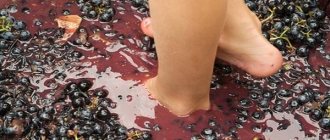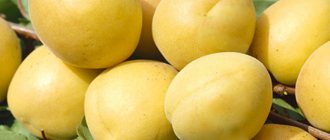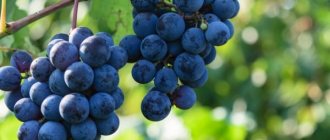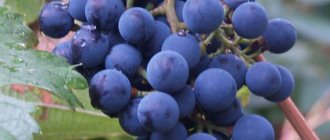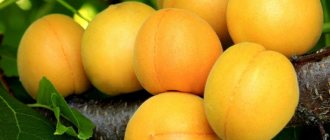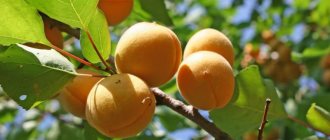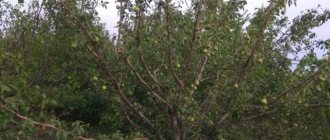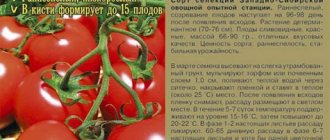History of appearance
The variety was obtained as a result of the work of breeder A. N. Venyaminov in 1938. The scientist was able to cross the “Red-cheeked” variety (southern large-fruited) with the early apricot “Trans-Baikal Northern”. The cultivar was bred and zoned in the Central Black Earth region.
Two decades later, cuttings of Northern Triumph came to Khabarovsk. After grafting onto the seedlings and crowns of the “Best Michurinsky” variety, it began to spread throughout the regions of Russia. Apricot Triumph Northern fully demonstrated its inherent qualities and won the gratitude of gardeners.
Reviews about Northern Triumph
★★★★★
Evgeny I. Novosibirsk region. Triumph should have been bearing fruit for 10 years already, during which time there were only two good harvests.
Generally very few fruits grow. The tree doesn’t really bloom or bear fruit – maybe I’m missing something. ★★★★★
Alina O., Chekhov. The tree is strong and tall, bears fruit well.
The first harvest was 3 kg. Now he produces 2-3 buckets of apricots. The tree is ideal for our region, the branches and buds successfully survived frosts of minus 37. The fruits are quite large - 40 g each. Compared to southern apricots, they are, of course, not as sweet, but for the Moscow region they are very good. Hide
Add your review
The creators of Northern Triumph did not exaggerate at all when they gave the variety such a pretentious name. This productive and frost-resistant apricot has become a real find for the middle zone and Siberia. The variety, without requiring special care, supplies its owners with fruits with high taste and commercial characteristics almost without interruption.
0
0
Copy link
Description of culture
The external parameters of the apricot variety are necessary for the gardener to properly plan the site. The height of the tree and the spreading of the crown affect the placement of fruit crops. This variety has a spreading crown, and the height of an adult tree is 4 m.
The branching is average, the skeletal branches and the tree trunk are thick.
Attention!
When marking the garden, you should take into account the area required for the growth and nutrition of the apricot.
The tree is actively developing. The leaf blades are large, their edges are pointed. The flowers are large and white. The pistils are much longer than the stamens. In years with early spring, flowers are formed without pistils. Scientists explain this fact by a shift in natural timing and heat deficiency.
The fruits are slightly elongated, the weight of one saplet is 30-40 g, but with regular care it reaches 50-60 g. The color of apricots during the harvest period is yellow-pink, the taste is sweet.
Like most northern varieties, the fruits are similar to cherry plums. The skin is slightly pubescent and of medium thickness. The pulp is juicy and can be easily separated from the large seed. Apricots hold tightly to the tree, and even in strong winds they do not fall off.
Description of the apricot variety Northern Triumph
The variety was obtained by crossing two popular varieties: Red-cheeked and Northern Early. He was bred by academician A. N. Venyaminov while working at the All-Russian Research Institute of Horticulture named after. I. V. Michurina. At first it was planted in the territories of the Central Black Earth Region, but later, having shown excellent qualities, it spread throughout central Russia, the Urals and Siberia. Under the right planting and care conditions, it bears fruit abundantly in the Moscow region and Leningrad region.
Did you know? Apricot kernels can be used as an addition to dishes as a substitute for bitter almonds. In addition, marzipan and other desserts are often prepared from small seeds.
Tree
A powerful spreading tree quickly grows to 4-5 meters in height. Thick skeletal branches are located at an angle of 45° to the trunk. Branching is average. The leaves are bright green, large, with a wavy edge and a sharp tip. White flowers with pink veins make the tree highly decorative during flowering.
Fruit
The weight of densely growing pubescent fruits can vary from 25 to 50 g, depending on care and agricultural technology. The skin of the berry is velvety, orange, with a speckled blush on the sunny side. The pulp is sweet with sourness, aromatic. The seeds are easily separated, their kernels are edible and have a pleasant almond flavor without bitterness.
The tasting score ranges from 4.2 to 5 points.
Characteristics
The characteristics of the variety include
- Edibility and taste of the seeds, reminiscent of almonds. Cooks value apricots for this quality.
- Precociousness. The first fruiting occurs 5 years after planting.
- Self-pollinating. Pollinators are not required for Triumph Northern apricot; the variety bears fruit well when planted alone.
- Resistance to major crop diseases, especially fungal ones. The variety does not require frequent preventive treatments. Can be quickly cured when problems arise.
- Apricot Triumph Northern demonstrates good adaptation abilities of the bark to temperature changes. But it should be noted that the kidneys are more susceptible to cold and can freeze.
The lifespan and fruiting life of an apricot is 40 years. Some gardeners consider this characteristic to be positive, while others would like a more durable variety.
Drought resistance, winter hardiness
The most valuable characteristic of the Triumph Northern apricot variety for Central Russia is its resistance to frost. Branches of the variety without lesions tolerate frost down to -40° C, but with a constant index. As soon as sudden temperature changes begin, annual shoots may freeze. Then fruiting continues for two or three years.
Buds react worse to low temperatures; their frost resistance is defined as average. Apricot Northern Triumph does not bloom in years with sudden spring frosts. The root system is located close to the surface, so the variety does not tolerate prolonged drought. The winter hardiness of the apricot variety Northern Triumph is considered above average.
Pollination, flowering period and ripening time
Pollinators are not required for this self-fertile variety. You can increase productivity by group planting with Amur and Best Michurinsky apricots. Other varieties whose flowering period coincides with Northern Triumph are also suitable. The tree blooms earlier than other species, the harvest is ready for harvest in the last ten days of July or early August.
Productivity, fruiting
The first harvest is harvested from the tree at the age of 3-4 years. Usually it is 4-5 kg per plant. As apricots mature, the yield constantly increases. The average value for a tree at the age of 10 years is 60-65 kg per plant.
Reviews from gardeners about the Northern Triumph apricot indicate instability of fruiting. Fruitful years alternate with periods of rest. This is due to the tree’s need to restore its strength. You can extend the fruiting age with proper tree pruning.
Resistance to diseases and pests
For gardeners, the resistance of apricot varieties to fungal infections is important. It shows good resistance to most diseases. In years with unfavorable weather conditions, he may suffer from cytosporosis, verticillium, monilliosis, and clasterosporiosis.
Advantages and disadvantages
Compared to other varieties, Triumph Northern has many advantages, including:
- Rapid onset of fruiting.
- Taste of fruits.
- Frost resistance.
- Strength of attachment of fruits and flowers.
- Suitability of kernels for food consumption.
- Self-pollinating.
- Disease resistance.
- Decorative appearance of a tree at the moment of flowering.
Gardeners do not have a consensus on the shortcomings. Some are dissatisfied with the size of the fruit, others do not like the quality of the preparations. But more significant disadvantages should be considered the possibility of freezing of flower buds and irregular fruiting.
Advantages and disadvantages of the variety
- Among the advantages of the variety over competitors are:
- high frost resistance and resistance to temperature changes;
- precociousness;
- large fruits ripen in a short summer;
- self-pollinating;
- wonderful dessert taste;
- ripened fruits do not fall off.
- The disadvantages of the variety are:
- irregularity of fruiting;
- possibility of flower buds freezing;
- harvesting is difficult due to the large height of the tree.
Landing Features
One of the main problems is the difficulty in purchasing high-quality planting material.
Attention!
Growing seedlings yourself is quite labor-intensive, so it is better to buy them from nurseries.
When planting Triumph northern apricot, it is important to provide the seedling with a comfortable and nutritious environment. In order for the tree to take root successfully, it must be planted correctly. Along with the usual method of planting seedlings - in holes, there is another option - planting on hills.
If the root collar of the seedling ends up in the ground, the plant will rot and die. No less dangerous are situations when the bottom of the trunk ends up in water - for example, during snow melting. In a humid environment, wood rots, food does not reach the roots, and the tree dies. Amateur gardeners, covering apricots with roofing material for the winter, sprinkling them with earth or humus, contribute to the death of the tree.
Landing technology
Northern Triumph seedlings are best purchased from a nursery, since growing from seed is too troublesome and a long process. In cold regions, planting should be carried out in April, before sap flow begins. In the southern regions, autumn planting is allowed.
Important! The root collar should always be open and dry; it should not be closed when loosening, mulched, or allow water to stagnate around the trunk when snow melts or after rainstorms.
In the selected area, a mound 30–50 cm high and 1.5–2 m in diameter is poured from a mixture of turf soil, compost, humus and sand in equal parts. Peat and manure are not added. The surface of the mound is compacted and a hole is made in the center with a diameter of 60–70 cm and a depth of 50–70 cm. The hole is spilled with 1-2 buckets of water, a seedling is placed in the center and the roots are straightened. Watering them periodically, cover them with soil mixture. The root collar of the apricot should be above the ground level.
The slopes of the mound are compacted and leveled, and for strengthening they are sometimes sown with perennial grass. If there are several seedlings, they are placed at a distance of at least 5 m from each other
Subsequent care of the crop
Northern Triumph inherited its low maintenance requirements from “Red-cheeked”. This variety does not cause any special worries. Care comes down to standard measures - watering, fertilizing, pruning. The main task of the gardener is to create comfortable conditions for the tree at the initial stage of life, and subsequently maintain its healthy condition, protecting it from frost in winter, and from parasites and diseases in summer.
Correct and systematic watering
Northern Triumph tolerates dry periods well and is watered infrequently. And if there are good rains, then watering is skipped. The main thing is that the tree trunk circle is loosened so that oxygen reaches the roots and rainwater is well absorbed. During drought, apricots are watered rarely, but generously. 2-3 waterings are enough. Approximate watering schedule:
- after flowering;
- during fruit growth;
- after harvesting.
The rate and frequency of watering varies depending on age. The older the tree, the less often the watering and the higher the volume. Until 4-5 years old, the tree is watered frequently, without waiting for the soil to dry out. The watering rate for a young tree is 30 liters, for an adult tree - from 50 liters per 1 m2.
Top dressing
Northern Triumph is fed three times a season. In spring, nitrogenous fertilizers are needed to increase green mass, during flowering and budding - potassium and microelements, in autumn - potassium and phosphorus to increase frost resistance.
| Timing and rates of fertilizer application | Time and dosage |
| Spring | Before or immediately after bud break. urea – 30 g per 10 liters of water; infusion of bird droppings – 1:20; mullein infusion – 1:10. |
| Spring. | Budding and flowering: complex fertilizer - Fertika, Clean Leaf and others; infusion of ash - take 2 liters of ash per 10 liters of water; fermented infusion of weeds - 1:5. |
| Autumn | superphosphate – 80-100 g, and potassium sulfate – 150 g; wood ash – 1.5 kg per tree. |
If ash is added, it must be fresh. The one that has been exposed to rain or stored in a humid environment has no nutritional value and does not alkalize the soil, but only loosens it. To apply fertilizer, you need to dig a groove or make several holes 15 cm deep along the perimeter of the crown. Having distributed the fertilizer evenly, water the holes or groove and then level it.
Pruning methods and timing
Pruning is the most difficult part of maintenance. Before you start pruning, you have to study its order and pattern. There are several types of pruning:
- Sanitary. Conducted in spring or autumn. Remove dry, diseased and damaged branches. Cut branches are burned, as they may contain pests and pathogens.
- Formative. Aimed at forming a beautiful and comfortable crown. It is carried out from the moment the seedling is planted.
- Supportive. Aimed at the active formation of young shoots and flower buds. It is carried out simultaneously with sanitary pruning. All branches, except skeletal ones, are shortened by 1/3.
Attention!
Apricot grows faster than other fruit trees and needs more frequent pruning. Mature trees have to be pruned especially often. When the annual growth decreases, the branches are cut back to the wood formed 2-3 years ago.
Features of apricot pruning:
- Apricots are pruned annually - in the spring, before the buds open, usually in mid-April.
- The branches are cut into rings so that there are no stumps left.
- The apricot crown needs annual thinning. Remove branches directed towards the ground, growing inside the crown, diseased, old, interfering with each other.
- Young shoots, strong and straight, are left, and crooked and weak shoots are cut off.
- You should not remove more than a quarter of the crown volume so that pruning does not become a shock to the tree.
- Shoots that do not bear fruit - shoots - are removed; too much effort is spent on them.
Preparing apricots for winter
Measures to prepare apricots for winter are not limited to the application of potassium-phosphorus fertilizers and moisture-recharging irrigations; it is also necessary to insulate the tree and protect it from rodents.
Sheltering work begins after the daytime temperature drops to 0 °C. Young seedlings are completely covered with agrofibre. Mature trees are insulated as follows:
- first, the trunks and skeletal branches are whitened with garden lime;
- they tie the trunk with spruce branches, lowering it down with needles;
- The trunk circle is covered with dry straw, hay, and the same spruce branches to protect the roots from freezing. In this case, the base of the trunk is not covered - they retreat from it by 15-20 cm.
You cannot wrap the trunks with film or cloth - during a thaw they will retain moisture, which will cause the bark to rot. It is necessary to monitor when the Northern Triumph apricot wakes up. This happens when the first warm days arrive. Be sure to take frost protection measures so that the flower buds do not freeze.
Characteristics of the variety
The height of an adult tree can reach 4 meters, the crown is spreading, with powerful and thick branches located at an angle of 45 degrees in relation to the trunk.
The foliage is large, has a slightly pointed shape with a jagged edge, and is colored rich green. It blooms with white and pink flowers, which have a positive effect on the decorative attractiveness of fruit plants. The root system goes deep into the soil by 40-50 cm.
Northern Triumph is a self-fertile hybrid, so it does not require nearby pollinators to bear fruit. It enters the flowering phase early; the first fruits can be collected in July-August. The berries are quite firmly attached to the branches, due to which they do not fall off when ripe.
It bears fruit with oblong-shaped berries, their color can vary from yellow-pink to orange with a red blush. The weight of one fruit will be 30-40 g, competent agricultural technology will allow you to increase these figures to 50-60 g. The skin is medium in density, velvety, with a sour taste, the flesh is juicy and sweet.
There is a large edible seed inside; its taste is compared to almonds, which is why it is used in cooking as a flavoring additive.
The variety is characterized by high winter hardiness of wood, so it remains viable in winter in the north, even when the thermometer drops to -35C, while the resistance of flower buds to frost will be less - -28C is considered a critical point for them.
Seedlings are characterized by precociousness, so with proper care you will be able to enjoy the first fruits already 3-4 years after they take root in the garden. The peak yield occurs in the 10-12th year of life; during this period, 50-60 kg of apricot can be harvested from one plant. The variety may experience failures in fruiting, but timely pruning will help avoid such problems.
Proper agricultural technology will allow you to have a fruit-bearing crop in the garden for about 35-40 years, the average lifespan of a tree will be 25 years. The berries are distinguished by their good transportability, so the hybrid is suitable for growing for commercial purposes.
Growing from seed
Gardeners can grow Northern Triumph from seeds by receiving free planting material. Procedure algorithm:
- Choose a beautiful, large, fully ripened fruit. Remove the bone from it.
- Soak it in water for 3-4 days. Then transfer it to a container with damp sand or moss.
- cover the container with plastic film with holes made in it;
- When the seed, having cracked, sprouts, it must be transplanted into the soil to a depth of 7 cm.
- Planting in the soil is done in summer or spring. The optimal time is May;
- the soil should be moistened from time to time and then mulched with humus or peat.
Over the summer, a seedling can grow 1 m, and after a year it can be transplanted to a permanent place or used for grafting onto a rootstock.
Features of watering
In order for the tree to develop well, it needs to be watered generously throughout the spring and June-July. The best method is to pour water into a shallow ditch dug around the perimeter of the crown. At a time, about 20–30 liters of water are consumed per 1 m2 of area for a young tree and up to 40–50 liters for an adult. By August, watering is reduced or stopped altogether (otherwise young branches begin to grow actively, which will not have time to get stronger before the winter cold).
A shallow ditch is dug around the tree for watering.
Harvesting and processing
If the fruits are to be eaten raw or dried, they are harvested when fully ripe.
Attention!
To transport the crop, you need to collect apricots at the stage of technical ripeness.
Don't be in too much of a hurry to pick the fruit. Even when ripe, they hold tightly to the branches.
Northern Triumph apricots are harvested on a sunny day. The dew should have evaporated by this time. It is best to schedule the collection for the morning or evening. When harvested during periods of cold weather or extreme heat, the fruits quickly deteriorate and their taste deteriorates.
Landing procedure and preparation for it
Since Northern Triumph is most often grown in regions where winter comes when it pleases, and not according to the calendar, the best time to plant a seedling is the end of April or the beginning of May. By this time the soil will have warmed up enough, the threat of frost is minimal. Over the summer, the tree will get stronger and have time to prepare for winter.
Selection of seedlings
It is best to plant one- or two-year-old apricots. The first looks like a stick about 50–60 cm high, the second has 2–3 side shoots. In any case, the bark should be even, smooth and shiny, without wrinkles or spots. A developed system of fibrous roots is required. Don’t rely on the “size matters” rule. Large seedlings take root less well.
When choosing an apricot seedling, you need to pay attention to the root system
Find out which tree the apricot was grafted onto. If plum was used as a rootstock, this will provide additional frost resistance and increase resistance to many diseases. Cherry plum and cherry reduce the sensitivity of the root system to flooding. Sloes contribute to the “miniaturization” of apricot trees. But peach and almonds are frankly a bad option for central Russia and colder regions. Frost resistance sharply decreases and demands on soil quality increase. Such trees also suffer much more often from diseases, especially from bacterial root canker, which in principle cannot be treated.
Selecting a location
Any apricot, even the most frost-resistant one, loves warmth and sunlight. In the shade, the fruits will either not ripen at all or will be small and sour. For Northern Triumph, you need to choose the warmest place on the site. At the same time, from the north it should be protected from gusts of cold wind by some natural or artificial barrier - a fence, a wall of a house, tall trees.
Apricot seedlings need to be protected from cold northern winds
The plant prefers soils that are light, well-permeable to water and air, such as loam. Heavy marshy or peaty soil is definitely not for it. In chernozem, apricots begin to bear fruit much later than expected, and yields decrease. In light sandy soil, the tree ages quickly and is more likely to get sunburned. It is also undesirable to oversaturate the substrate with nitrogen.
Apricot categorically does not tolerate acidic soil (the optimal pH is 6.0–7.0) and excess moisture in it. If groundwater comes closer to the surface than 2 m, look for another place or build a hill at least 50 cm high. In the latter case, you will have to take additional care of drainage.
Another unsuitable place is lowlands. Cold, humid air stagnates there for a long time, and in the spring the melt water does not leave. The ideal option is a gently sloping hillside oriented southeast or southwest.
Preparing the planting hole
For spring planting, the pit is prepared in the fall. Its depth and diameter are 65–70 cm. If you plan to plant several trees, leave at least 5 m between them.
When drainage is needed, crushed stone and small ceramic shards are poured onto the bottom. The top layer of soil removed from the hole (15–20 cm) is laid aside separately. Approximately the same amount of peat, sand and powdered clay are added to this soil. Fertilizers are also added - humus (15–20 l), simple superphosphate (350–400 g), potassium sulfate (150–200 g). If the soil is acidic, you will need dolomite flour or crushed chalk (500 g/m²).
The planting pit for apricot is prepared in advance
All this is mixed well and poured into the bottom of the pit, forming a mound. Then it is covered with some waterproof material (for example, slate) and left until spring.
Step by step landing procedure
The apricot planting itself is no different from a similar procedure for other fruit trees. It’s better to do it together – it’s more convenient.
- 15–20 hours before planting, soak the roots of the seedling in water at room temperature with the addition of potassium permanganate (until pale pink) and any liquid biostimulant (30–40 ml per 10 l). If there are any leaves, tear them off.
- Trim the roots, shortening them by about a third. Dip them in a mixture of powdered clay and fresh manure. A properly prepared mass has a thick consistency, similar to rich sour cream. Let dry for 2-3 hours.
- A little away from the top of the mound at the bottom of the planting hole, drive a peg 25–30 cm higher than the seedling.
- Pour 20–30 liters of water into the hole. When it is absorbed, place the seedling on the top of the mound. Correct roots that bend upward. If the tree was sold in a container, plant it together with a ball of earth.
- Fill the hole with soil in small portions. From time to time it needs to be carefully compacted and the tree shaken so that there are no voids left. Be careful not to deepen the root collar. It should be 5–8 cm above the soil surface. The soil will soon settle.
- Water the tree again (20–25 liters of water). To prevent it from spreading, form a low earthen mound, moving 60–70 cm away from the trunk.
- When the moisture is absorbed, mulch the tree trunk circle with peat chips, humus, and freshly cut grass. Tie the tree securely to the support, but do not overtighten.
- Trim off any side shoots, if any. Shorten the central one by about a quarter.
Even a novice gardener can cope with planting apricots.
Video: planting an apricot seedling in the ground
Diseases and pests, methods of control and prevention
The variety is quite resistant to diseases and pests, but prevention should not be neglected. Recommended preventive measures:
- Cleaning and destroying fallen leaves. They are not sent to compost - it is better to burn them, as they may contain fungal spores and pest larvae.
- Sanitary pruning followed by destruction of cut branches. After combustion, a valuable fertilizer is obtained - ash.
- Autumn digging of the soil - fungal spores, beetles, larvae raised to the top die from frost.
- Whitewashing trunks and installing hunting belts. Prevents pests from entering.
- Autumn tying of trunks with roofing felt - against rodents.
- In autumn and spring - stripping the damaged bark, followed by treating these areas with a 3% solution of copper or iron sulfate. In early spring - preventive spraying with fungicides and insecticides.
Common diseases of apricot Northern Triumph:
| Diseases | Signs | Treatment options | Prevention |
| Clusterosporiasis | The leaves become covered with brown spots, in place of which holes appear over time. There are cracks on the shoots with gum leaking out. | Spraying with Bordeaux mixture 1% or copper sulfate 1%. Spray the buds in the spring and spray the branches in the fall when the leaves fall. In rainy summers, treatment is every half month. | During budding, spray with Horus (3 g per 10 liters of water). Affected branches and fallen leaves are trimmed and burned. |
| Moniliosis | The petals turn brown and dry out. Then the leaves and shoots dry out, there are cracks in the bark, and the fruits rot. | Spray with copper oxychloride 0.3%, Topsin solution 0.1% or Skor 0.02%. | During pruning, cover the sections with garden varnish. The trunks are whitened with lime and copper sulfate. |
| Cytosporosis | The tree withers starting from the top. There are dark spots on the bark. The branches are drying out. The tree is at risk of dying. | Spraying with Topaz, Skor or Cuprozan. | Cutting dry branches |
The most common pests of this apricot variety
| Pest | Description | Ways to fight | Prevention |
| leaf roller | The caterpillar, having overwintered in the bark and fallen leaves, eats leaves and buds in the spring. | Spraying with Decis, Inta-vir, Entobacterin. | Digging up tree trunk circles. Cleaning the bark with a wire brush. Whitewashing the trunk and skeletal branches |
| codling moth | Having hatched in the second half of summer, the caterpillars eat the pulp of the fruit. | Spraying with Entobacterin (per 10 l - 60-100 g) or 0.2% Chlorophos. | Destroying fallen leaves and digging up the soil. |
| Aphid | Sucks juices from shoots and leaves. The foliage curls and fades. | During the period of dormant buds - 3% Bordeaux mixture, during blossoming - 2%, during the growing season of shoots - 1%. Also sprayed with Karbofos 0.3%. | Fighting anthills. Planting calendula. |
Care
Northern Triumph inherited its unpretentiousness in terms of agricultural technology from its mother plants, so care for it will be limited to performing simple gardening work.
Watering
The hybrid is a drought-resistant variety, which means it will not need frequent watering. With regular natural precipitation, an adult tree will not need additional moisture. In dry summers, watering is carried out once a month - in the spring after the flowering phase, during the period of fruit growth, after harvesting. After each introduction of moisture, loosening of the tree trunk circle will be required to improve aeration and access of moisture to the roots.
A young seedling should be watered regularly; the frequency of work will depend on the condition of the soil in the tree trunk circle - the soil near the root system should not dry out.
Top dressing
After planting, the tree will need fertilizers for the 4th year, when the crop will already be formed. For feeding, use organic matter - humus or compost every 3-4 years. Every spring, apricots are watered with mineral compounds; in the fall, superphosphate is introduced into the tree trunk.
Trimming
The yield of the fruit crop will depend on the correct formation of the crown. The hybrid will require sanitary and anti-aging pruning. In the first case, dry and damaged branches are removed in the spring, the length of healthy branches is reduced by a third. A rejuvenating haircut will be required when fruiting declines in the fall.
Preparing for winter
In autumn, the trunk and skeletal branches must be whitened with lime. To protect against rodents and freezing, young seedlings are covered entirely by constructing special frames made of agrofibre or other covering material with ventilation holes.
For mature trees, the trunks are tied with twine for the winter and additionally wrapped in spruce branches. The tree trunk circle is mulched with straw or sawdust; the layer thickness should be at least 15-20 cm.
Reproduction
Apricot Northern Triumph can not only be purchased, but also grown independently. There are several methods of reproduction.
Cuttings
Green shoots for planting are harvested in the spring, kept in a growth stimulator and rooted in the garden. During the first month, you will need to regularly moisten the soil; within 2-3 weeks, fibrous roots will begin to form. After a year, the young seedling can be transplanted to a permanent place.
Landing
In order for a fruit crop to take root in the garden and begin to bear fruit, a number of important nuances should be taken into account during its rooting.
Selection and storage of seedlings
It would be more correct to purchase a young plant in the fall, no older than 2 years. Self-exposure will give you confidence that the planting material has been prepared correctly for spring planting.
An annual crop will be suitable for purchase; usually it is a small seedling, about half a meter long; a two-year-old plant already has several side shoots. The bark of the tree should not contain damage or other defects.
The purchase of planting material with a closed root system will increase the chances of survival, which will prevent its damage and drying out during transportation.
If the seedlings being sold were grown by grafting, before purchasing it is worth clarifying what crop it was used on. Planting material grafted onto a plum will be immune to many diseases, a hybrid on a sloe will be small in size, and cherry plum or cherry will give the plant resistance to high humidity in the soil.
Before planting, seedlings should be stored by keeping the roots in a solution of clay and mullein, then wrapped in damp burlap or rags and covered with film on top. The gardener will need to regularly check the condition of the roots; they should not dry out.
Before planting, the tree should be left in the basement or any other room where the air temperature will be from 0C to +5C. In southern latitudes, seedlings are buried in the plot in the fall; in this case, they will need to be insulated with straw and protected from rodents.
Preparing for landing
Northern Triumph is rooted in open ground in the spring, when the risk of return frosts is minimal. Depending on the region, work can be carried out from April to mid-May. It is important to wait until the earth warms up to +5C.
Until the planned date of work, the seedling should be kept in the basement so that the plant does not wake up ahead of time. In rare cases, rooting is carried out in the fall - in October.
A well-lit area protected from the wind is best for planting. You can root the apricot in a place where there will be some kind of barrier on the north side. This could be a building, a fence or another tall tree.
But it is worth considering that the variety is an individualist plant, so it is better to allocate a separate place for it in the garden without other fruit crops, with the exception of group planting of different types of apricot.
It is better to root young seedlings in neutral or slightly alkaline soil, with an acidity of 6-7 pH. The soil in the garden should be light and loose to maintain good aeration and access of moisture to the roots when watering. The optimal groundwater level will be 1.5-2 m.
Rooting algorithm
The best option would be to root the seedlings on specially made hills, which will prevent rotting of the root system.
In this case, instead of a planting hole for a tree, a hill is made from a substrate that includes sand, garden soil, compost and humus.
Planting technology:
- from the soil mixture, an elevation is made with a height of 50 cm and a diameter of 100 cm;
- a depression is formed at the top, measuring 1/3 of the length of the root system;
- the substrate is well moistened;
- the seedling is placed in the center, the roots are straightened, sprinkled with soil up to the root collar;
- level the embankment so that there is a gentle slope from the trunk;
- tie the planting material to the support;
- form a tree trunk circle, water and mulch;
- branches are pruned by 5-10 cm, but provided there are no more than 2 buds on each.
When planting in groups, trees should be placed in increments of 4-5 m.
Table: how, when and with what to feed apricots?
| Fertilizer | Period | Quantity |
| Nitrogen fertilizers (urea) | Before flowering, after flowering, after the ovaries fall off | 35 g per 1 m2 |
| Potassium fertilizers (potassium nitrate) | After the apricots ripen | 50 g per 1 m2 |
| Phosphate fertilizers (superphosphate) | Before flowering, after flowering | 60 g per 1 m2 |
| Organic | Once every 2 years (early spring or late autumn) |
|
It is worth keeping in mind that apricot needs both mineral and organic fertilizers.
Features of culture
Like many species adapted to grow in temperate climatic zones, the variety is endowed with the main quality - the ability to survive and produce crops in temperate climatic latitudes, which are famous for very difficult conditions. Gardeners in the Moscow region fell in love with northern apricot Triumph precisely for these qualities. Among the northern varieties, Triumph has long been considered the best, and this is confirmed not only by its high frost resistance of branches and flower buds, but also by its low susceptibility to various kinds of diseases and damping off.
Pruning is the basis of care
Apricot tree pruning should be done in early spring, before the buds open. Branches to be removed: damaged by disease, dry, frozen, too long, growing inside the crown.
Apricot pruning should be done already in the first year of life. The branches are cut by about a third, stimulating branching and thus forming a beautiful, even crown. Pruning is always done with a sharp garden tool (scissors or pruning shears); the cut areas should be lubricated with varnish to prevent infection.
Regular pruning will ensure ventilation of the crown, protect against pests and diseases, and make the tree more resilient. Apricot will reward you with a good harvest of ripe fruits. It’s just important not to overdo it: no more than 1/4 of the crown is removed during pruning.
Video: whitewashing and pruning fruit trees
Harvesting
Northern Triumph is a fast-growing variety. It produces a harvest already in the 5th year of life. If a large number of fruits have formed on a young tree, and the branches are still too weak for such a load, then the ovaries need to be thinned out. The calculation is as follows: 1 apricot per 20 leaves. A plant older than 10 years with proper care produces from 20 to 60 kg per season.
The fruits of this variety ripen in late July - early August. The harvest should be harvested in clear weather, in the morning at 10–11 o’clock, when the dew has dried, or in the evening at 17–19 o’clock. Apricots collected raw do not store well and do not last long. If you plan to transport fruits, it is better to collect them during the period of so-called technical maturity - a few days before full ripening.
Northern Triumph is perfect for both canned preparations and fresh eating.
Due to the almond flavor of the seed, gardeners recommend not removing it from the fruit when making jam.
Northern Triumph is perfect for both canned preparations and fresh eating.
Reviews from gardeners about the variety
The variety turned out to be very successful for the middle zone. Even in my northern part of the Moscow region, the variety shows excellent winter hardiness of both skeletal branches and fruit buds, which survived -37 this winter. It bloomed in the 3rd year after grafting onto a damson seedling. The taste is good, the average fruit size is 40 grams. It is practically not damaged by diseases, but it, like other apricots, is powerless against moniliosis. Our sugar levels are good. Of course, in terms of taste it cannot be compared with good southern varieties, but for the middle zone it is very good.
Anona
https://forum.vinograd.info/showthread.php?t=11652
On the neighboring plot, apricot of the Triumph northern variety has been growing for about 5 years. A tall, strong tree, this summer we collected about 3 kg of fruits from it, quite large and tasty. In addition to all its other advantages, it is also self-fertile. IMHO, this variety is most suitable for our conditions (Moscow region).
April
https://www.websad.ru/archdis.php?code=707723
10 years ago I planted an apricot variety “Northern Triumph”. Excellent variety. Already in the 4th year I received a good harvest. In addition, the fruits have excellent qualities - sweet, juicy and large. And their aroma is truly amazing. They bear fruit almost every year, sometimes there are breaks, but still on average I harvest up to 60 kilograms of harvest!
Nikolai
https://6sotok-dom.com/ogorod/frukty/abrikos/sorta-triumf-severnyj.html
Northern Triumph is not named so for nothing - the variety, thanks to its frost resistance and unpretentiousness, is suitable for growing in the Moscow region, the central zone of the country, and Siberia. Gardeners fell in love with it for its early fruiting and high yield. In addition, in spring the garden becomes especially beautiful due to the early flowering of Northern Triumph.
- Author: Diana Nikiforova
I never cease to be convinced that life is wonderful. Rate this article:
- 5
- 4
- 3
- 2
- 1
(1 vote, average: 4 out of 5)
Share with your friends!
Positive and negative qualities of the Triumph Northern variety
Apricot Triumph Northern suggests many positive aspects, but there are also negative aspects.
| pros | Minuses |
| Fast fruit ripening | Irregularity of fruiting |
| Excellent apricot taste | Possibility of flower buds freezing |
| High frost resistance | |
| Apricots are tightly attached to the stalks | |
| Self-pollinating variety | |
| Resistance to diseases, beetle attacks | |
| Decorative effect of an apricot tree with pollen |


